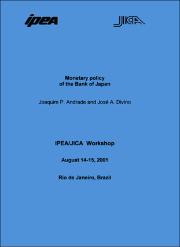Please use this identifier to cite or link to this item:
https://repositorio.ipea.gov.br/handle/11058/13875Full metadata record
| DC Field | Value | Language |
|---|---|---|
| dc.contributor.author | Andrade, Joaquim Pinto de | - |
| dc.contributor.author | Divino, José A. | - |
| dc.contributor.author | IPEA/JICA Workshop : Modeling the Brazilian Economy (2001 : Rio de Janeiro, RJ) | - |
| dc.coverage.spatial | Japão | pt_BR |
| dc.date.accessioned | 2024-05-27T19:15:58Z | - |
| dc.date.available | 2024-05-27T19:15:58Z | - |
| dc.date.issued | 2001-08 | - |
| dc.identifier.citation | ANDRADE, Joaquim Pinto de; DIVINO, José A. Monetary policy of the Bank of Japan: inflation target versus exchange rate target. . In: IPEA/JICA WORKSHOP, 2001, Rio de Janeiro. Modeling the Brazilian Economy. Rio de Janeiro: Ipea: DIMAC: JICA, 2001. Disponível em: https://repositorio.ipea.gov.br/handle/11058/13875 | pt_BR |
| dc.identifier.uri | https://repositorio.ipea.gov.br/handle/11058/13875 | - |
| dc.description.abstract | O artigo revisa as evidências sobre a política monetária do Banco do Japão. As novas evidências empíricas trazidas por esta análise confirmam a tese de McKinnon e Ohno (1997) de que o BOJ tem tentado estabilizar a taxa de câmbio. A função de reação estimada sugere que choques na taxa de câmbio afetam a taxa de juros de curto prazo, juntamente com a diferença do produto. A modelagem de séries temporais, através de um ADL, indica que a taxa de juros é contracíclica em relação à taxa de câmbio. Finalmente, a análise de decomposição histórica revela que a estabilização da taxa de câmbio tem sido um objetivo importante, particularmente durante o período da bolha. | pt_BR |
| dc.language.iso | en-US | pt_BR |
| dc.publisher | Instituto de pesquisa econômica aplicada (Ipea) | pt_BR |
| dc.title | Monetary policy of the Bank of Japan : inflation target versus exchange rate target | pt_BR |
| dc.type | Eventos | pt_BR |
| dc.rights.holder | Instituto de pesquisa econômica aplicada (Ipea) | pt_BR |
| dc.source.urlsource | https://www.ipea.gov.br/ | pt_BR |
| dc.location.country | BR | pt_BR |
| dc.description.physical | 18 f. | pt_BR |
| dc.subject.vcipea | IPEA::Política Econômica. Política Social. Planejamento | pt_BR |
| dc.rights.license | É permitida a reprodução deste texto e dos dados nele contidos, desde que citada a fonte. Reproduções para fins comerciais são proibidas. | pt_BR |
| dc.subject.keyword | Política monetária | pt_BR |
| dc.subject.keyword | Bancos centrais | pt_BR |
| ipea.description.additionalinformation | Workshop realizado nos dias 14-15 de agosto de 2001. | pt_BR |
| ipea.access.type | Acesso Aberto | pt_BR |
| ipea.rights.type | Licença Padrão Ipea | pt_BR |
| ipea.englishdescription.abstract | The article reviews the evidence on the monetary policy of the Bank of Japan (BOJ). The new empirical evidence presented in this analysis confirms the thesis of McKinnon and Ohno (1997) that the BOJ has been attempting to stabilize the exchange rate. The estimated reaction function suggests that shocks to the exchange rate affect the short-term interest rate, along with the output gap. Time series modeling, through an Autoregressive Distributed Lag (ADL) approach, indicates that the interest rate is countercyclical with respect to the exchange rate. Finally, the historical decomposition analysis reveals that exchange rate stabilization has been an important objective, particularly during the bubble period. | pt_BR |
| ipea.researchfields | Macroeconomia para o Desenvolvimento | pt_BR |
| ipea.classification | Economia. Desenvolvimento Econômico | pt_BR |
| Appears in Collections: | Economia. Desenvolvimento Econômico: Eventos | |
Files in This Item:
| File | Description | Size | Format | |
|---|---|---|---|---|
| monetary policy of the bank of japan.pdf | 1.08 MB | Adobe PDF |  View/Open |
Items in DSpace are protected by copyright, with all rights reserved, unless otherwise indicated.

